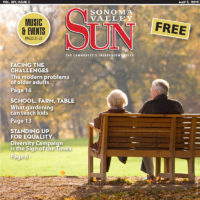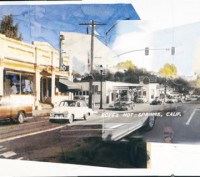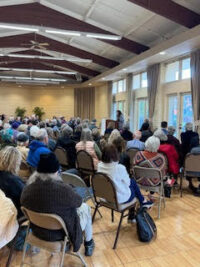By Mary Nesbitt
Two California laws anchor the public’s right to know how state and local governments do business, make decisions and spend public money. The Ralph M. Brown Act requires open meetings, with agendas published beforehand, so that the public can witness elected officials in the act of deliberation and have a chance to participate.
Through the Public Records Act, anyone can access written, visual and electronic material produced in the course of government doing the people’s business. This is often transparency after the fact: an action or decision has already been taken and a member of the public wants to know how it came about or get information the agency has not shared.
The devil, as always, lurks in the details. Here are just three you may encounter.
Exempt, really? There are legitimate exceptions to transparent everything, and agency lawyers, being lawyers, like to argue them to the limit. Few people have the time, experience or persistence to make public records requests, or the money to file lawsuits if their efforts are obstructed. Earlier this year the “Press Democrat” tried to determine how much money Sonoma County Tourism spent on its Super Bowl promotion. Tourism refused, because releasing the information would reveal trade secrets to competitors. Only after the nonprofit First Amendment Coalition sued was the information, clearly not a trade secret and not exempt, produced. Tourism also paid the Coalition’s legal bills for an action that shouldn’t have been necessary in the first place.
Artful dodges. There are other ways to skirt the requirements; for instance, by not preserving records in the first place, by not using government email, or by using personal devices to conduct the people’s business. A few weeks ago, the Coastal Commission refused to provide email and phone records of commissioners speaking via private accounts with lobbyists about Commission business. The San Jose “Mercury News” sought the records as part of their investigation into the firing of Executive Director Charles Lester. A similar case from 2009 involving email records of San Jose politicians is now before the state Supreme Court.
Quasi-government organizations aren’t covered. While the statutes apply to government agencies, including school boards, they do not cover the legion of private consultants and contractors who carry out public projects. Many are effectively quasi-governmental agencies and derive most of their funding from public money.
Transparency in practice depends on whether or not officials are genuinely committed to openness beyond the statutory minimum. Even in Florida, a state with the longest and strongest history of “sunshine” legislation, the average grade in a website transparency study of 66 counties and 45 cities by the First Amendment Foundation was just over 50 per cent.
After several decades in journalism, I’ve come to understand that the real barrier to transparency in agencies is attitudinal – what must an agency provide to meet the legal requirements v. what can it proactively provide to serve the public interest. What’s missing is an outside-in understanding of what the public, not the agency, thinks is in their interests.
Most Americans now go online to seek information, services and records from government online, research shows. Many seek simple pieces of information or transactions — how to get a building permit, pay water bills online, find an official and so on. But a segment of the public – call them civically engaged – wants to delve into information that helps them understand issues, background, trends and agency performance. They don’t want their civic news and information to be filtered by public relations or marketing departments. Or the news media. They want to be well-informed voters, contributors to public discussions and able to hold public officials accountable.
Accountability can’t happen without transparency. Openness encourages a better-informed public and promotes participation. Along the way, it might even help build public trust in government.
Valley and County agencies can make much progress on transparency without major expense.
Share the knowledge proactively. Agencies already produce a shed-load of good information and data, reports and regular updates, in the course of business. They commission consultants’ studies on a range of topics. They do surveys. Staff and politicians give scripted speeches and presentations. Agencies pursue grants from other agencies in applications that require the large amounts of information about themselves and their project plans. Yet only a tiny sliver is ever published online for the benefit of the people whose tax dollars make it possible.
Get an excellent search engine. Some agency websites have a quite a bit of information, but poor organization, navigation and search. The City of Sonoma, for instance, used to have a good engine that scoured everything, including agendas and minutes – crucial if you are trying to find an official record of what happened when. The new engine on its “improved” site is terrible. Try searching topics like leaf blowers, minimum wage, First Street East or dogs, all topics on which much city ink has been spilled.
Ask people what they want to know. It’s important to build transparency from the outside-in. Ask people what would help them make informed contributions to civic affairs and hold officials accountable. The League of California Cities has plenty of resources on openness.
Give up trying to control the message. It doesn’t work any more. Says the communications firm Cision: “If you’re still trying, stop. In PR we can position, and we can steer, but eventually the message is controlled by the general public. There are no longer a few channels distributing information. Social media has given everyone a megaphone. And every review and opinion out there creates the message as a whole.” This points to a different role for communication departments.
It’s more credible to publish the bad with the good. News emanating from agencies is mostly sunny. For instance, in 2015, Sonoma County Water Agency published 31 press releases, all of which announced meetings, events, programs and achievements. Nothing wrong with communicating that. But the public would never know, for example, that in June 2015, the agency agreed to a $732,300 fine from the Water Quality Resources Board as a settlement for 46 sewer overflows in Sonoma Valley from 2011 to 2014. The Board also imposed a cease and desist order, given the agency’s history of failing to properly manage and maintain part of its Valley collection system. As in the private sector, failure to ‘fess up to problems makes it look as if government is hiding something and harms credibility.
Post salaries of public employees. Or direct the public to sites that do, such as www.transparentcalifornia.com, which has salaries for public employees in cities, counties, state, universities, community and colleges, K-12 and charter schools.
Post minutes promptly after meetings and label them “Draft.” Delaying until minutes are approved at a subsequent meeting is unnecessary. In the case of monthly meetings, which are sometimes cancelled, the gap can be months. Drafts can be swapped out when the minutes are approved.
Post all Requests For Proposals, bids, winner and contract. Also provide a running list of awards and value of contracts, regardless of size, in downloadable spreadsheet form.
Publish datasets with relevance and context. SoCo Data (www.data.sonomacounty.ca.gov) launched with fanfare from the Board of Supervisors last July to promote “transparency and openness.” The great majority of datasets come from Santa Rosa, and they include building permits, city salaries, top retirement and health costs, up-to-date police incidents, housing enforcement cases, engineering permits, planning projects and water permits. The County’s contributions so far are baby names, sheriff’s incidents, commuter data on County employees, food inspections, and some impenetrable budget spreadsheets. Hopefully this is a work in progress and Valley residents will be able to see and work with other relevant data soon.
Looks v. substance. The Sonoma County Agricultural Preservation and Open Space District’s new website is beautiful, well designed and navigable. Kudos for publishing current and past budgets and audits. But an agency with a current budget of $48 million needs more civic substance to match the aesthetics.
• The District has purchased hundreds of easements and properties, large and small, since 1990 to preserve Sonoma County’s breathtaking and environmentally important landscape. It’s quite an accomplishment. There’s a map of all properties and a blurb on each. What’s missing is a comprehensive, downloadable spreadsheet listing the properties, type, ownership, size, location, date and cost of acquisition. There should be links to agreements with fee title and easement holders.
• The District received a critical management review in 2014 and has been working on improvements. The review should be posted, with progress toward targets.
• Post annual District objectives and work plan.
• Post draft minutes of the Fiscal Oversight and Advisory committees promptly — they are months behind.
• Publish reports and presentations given at meetings. Currently people must go to the District’s office to see them.
• Publish news. For instance, earlier this year the District signed an $8 million federal grant agreement, part of a $21 million project to “develop and implement a shared, proactive, positive vision for conservation of working lands and natural areas resulting in agricultural systems that conflict less and are more symbiotic with natural resources.” Not newsworthy, apparently.
• Post management plans for properties; also manuals and documents that guide District work.
Sonoma County prides itself, with some justification, for being innovative. In this election year, who’s for innovation in government transparency?














Be First to Comment